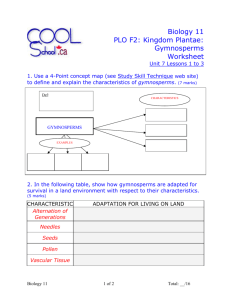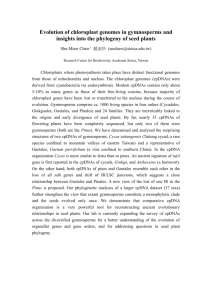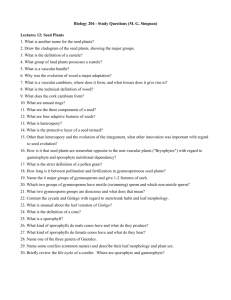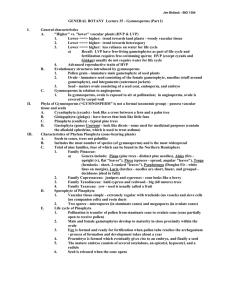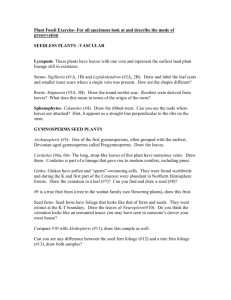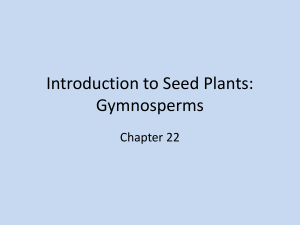Chapter 19
advertisement
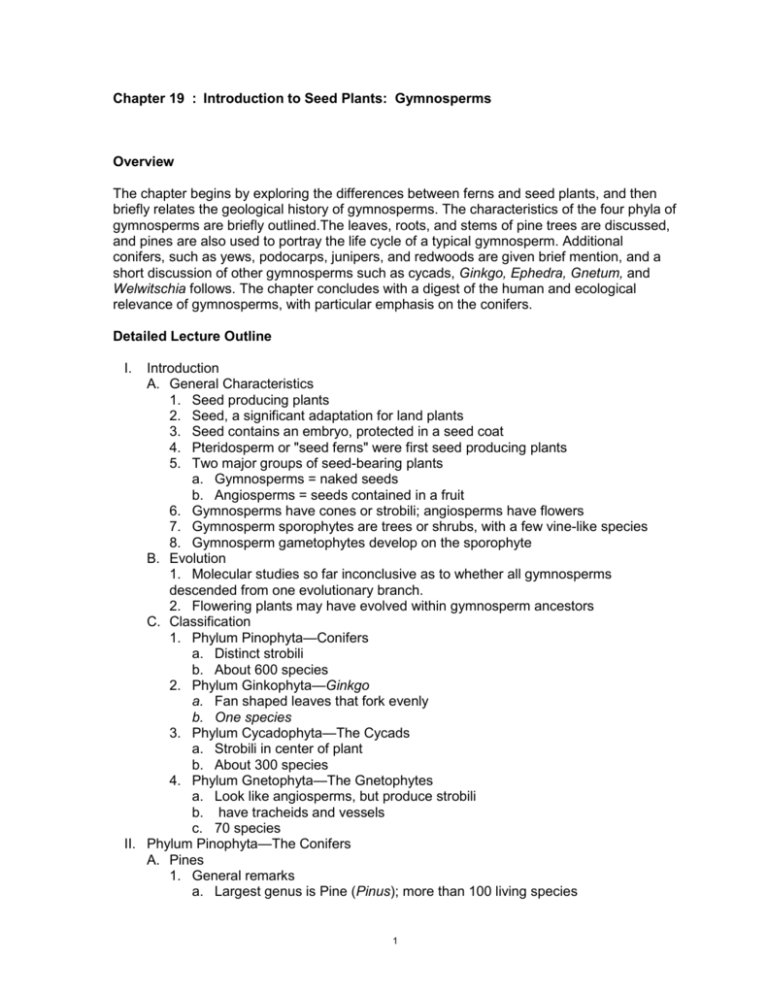
Chapter 19 : Introduction to Seed Plants: Gymnosperms Overview The chapter begins by exploring the differences between ferns and seed plants, and then briefly relates the geological history of gymnosperms. The characteristics of the four phyla of gymnosperms are briefly outlined.The leaves, roots, and stems of pine trees are discussed, and pines are also used to portray the life cycle of a typical gymnosperm. Additional conifers, such as yews, podocarps, junipers, and redwoods are given brief mention, and a short discussion of other gymnosperms such as cycads, Ginkgo, Ephedra, Gnetum, and Welwitschia follows. The chapter concludes with a digest of the human and ecological relevance of gymnosperms, with particular emphasis on the conifers. Detailed Lecture Outline I. Introduction A. General Characteristics 1. Seed producing plants 2. Seed, a significant adaptation for land plants 3. Seed contains an embryo, protected in a seed coat 4. Pteridosperm or "seed ferns" were first seed producing plants 5. Two major groups of seed-bearing plants a. Gymnosperms = naked seeds b. Angiosperms = seeds contained in a fruit 6. Gymnosperms have cones or strobili; angiosperms have flowers 7. Gymnosperm sporophytes are trees or shrubs, with a few vine-like species 8. Gymnosperm gametophytes develop on the sporophyte B. Evolution 1. Molecular studies so far inconclusive as to whether all gymnosperms descended from one evolutionary branch. 2. Flowering plants may have evolved within gymnosperm ancestors C. Classification 1. Phylum Pinophyta—Conifers a. Distinct strobili b. About 600 species 2. Phylum Ginkophyta—Ginkgo a. Fan shaped leaves that fork evenly b. One species 3. Phylum Cycadophyta—The Cycads a. Strobili in center of plant b. About 300 species 4. Phylum Gnetophyta—The Gnetophytes a. Look like angiosperms, but produce strobili b. have tracheids and vessels c. 70 species II. Phylum Pinophyta—The Conifers A. Pines 1. General remarks a. Largest genus is Pine (Pinus); more than 100 living species 1 b. Trees of the coniferous forests c. Bristle-cone pines 1) Oldest known living organisms 2) Occur in White Mountains of California 2. Structure and form a. Leaves are needle-like (in clusters or bundles called fascicles) 1) Adapted for harsh environments a) hypodermis b) thick cuticle c) sunken stomata d) no air space system in mesophyll • conserves water with this arrangement 2) Leaves abcise but not all at once 3) Resin canals • resin, prevents fungus growth and insect feeding b. Wood is classified as softwood (versus hardwood of broadleaf trees) 1) Absence of fibers 2) Tracheids only, no vessels 3) Annual rings c. Bark may be extremely thick, insulates tree trunk against forest fires • giant redwoods d. Roots associated with fungus, called mycorrhizae 3. Reproduction a. Heterospory b. Pollen cones (male) and seed cones (female) c. Microsporangia and megasporangia d. Microspores develop into pollen grains (male gametophytes) e. Tube cell = pollen tube plus tube nucleus f. Megaspores develop into female gametophytes g. Embryo develops at ends of suspensor cells connected to rosette cells h. Ovule = nucellus (megasporangium) with an integument B. Other Conifers 1. Yews • seeds with fleshy, cup-like covering called an aril 2. Podocarps • planted as ornamentals 3. Junipers 4. Redwoods a. Sequoia giganteum = Big Tree or Giant Redwood • western slopes of California's Sierra Nevada mountains b. Sequoia sempervirens = Coastal Redwood C. Other Gymnosperms 1. Phylum Ginkgophyta—Ginkgo a. Structure and Form 1) Trees with fan-shaped leaves 2) Single species, Ginkgo biloba, called Maidenhair Tree or Silver Apricot b. Other Features 1) Plant survives only because of cultivation 2) Considered a living fossil 3) Seeds resemble plums, have rank odor 2. Phylum Cycadophyta—The Cycads 2 a. Structure and Form 1) Single unbranched stocky stem 2) Palm or fern-like foliage 3) Male and female cones on separate plants 4) Slow growing plants b. Other Features 1) Sub-tropical plants; Mexico, Cuba, Africa 2) Considered living fossils 3. Phylum Gnetophyta—The Gnetophytes a. Classification 1) 70 species among only 3 genera 2) Ephedra a) Shrubby plants called joint firs b) Inhabit drier regions of the world 3) Gnetum a) Vinelike plants with broad leaves b) No English common name for this plant c) Best known species is tree that grows up to 10 meters tall 4) Welwitschia a) Only one species b) Confined to Namibian desert of southwestern Africa (Namibia) c) Most unusual in appearance d) Long taproot with two strap-like leaves e) Obtains its water from fog b. Other Features • vessels in the xylem, all other gymnosperms have tracheids III. Human and Ecological Relevance of Gymnosperms A. Conifers 1. Pine trees—"many parts are edible" • bark and seeds 2. Masts of sailing vessels (eastern white pine) 3. Turpentine and rosin • naval stores, caulking and sealing wooden sailing ships 4. Amber • fossilized resins with entrapped insects 5. Pulpwood • major source is white spruce 6. Soundboards of musical instruments (violins, etc.) 7. Douglas fir • lumber 8. Arborvitae • ornamentals 9. Juniper berries • used to flavor gin 10. Pacific yew a. taxol, a drug with anticancer properties, obtained from bark b. recommendation by NIH in 2001 that taxol be used for certain lung cancers and ovarian cancers B. Other Gymnosperms 1. Arrowroot starch (from cycads) 2. Ginkgo 3 a. Seeds edible b. Leaf extracts improve blood supply to brain and lungs c. Effects on memory enhancement inconclusive 3. Mormon tea • from Ephedra leaves 4. Ephedrine drug • from Chinese Ephedra 5. Gnetum rope (used in Java) • from bark fibers 4

